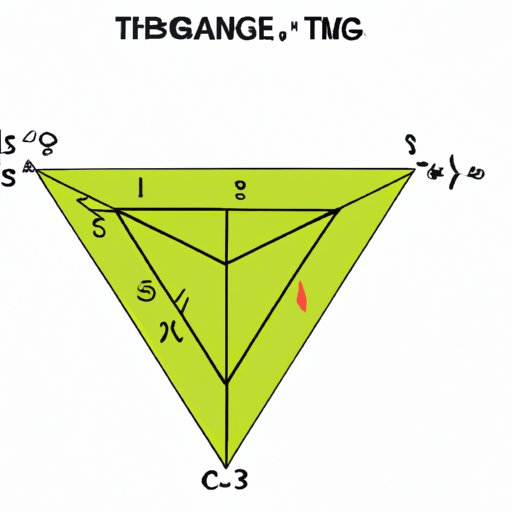
Introduction
Triangular shapes are all around us, from the roofs of houses to the branches of trees. It is important to know how to find the side of a triangle, whether you are designing a building or trying to navigate your way through a forest. This article will provide you with a comprehensive guide to finding the side of a triangle using various techniques.
A Beginner’s Guide to Finding the Side of a Triangle
A triangle is a three-sided polygon that has three angles. Triangles can be classified based on their sides and angles. There are three basic types of triangles: equilateral, isosceles, and scalene. The formula for finding the sides of a triangle is the Pythagorean theorem, which states that the sum of the squares of the two shorter sides of a right triangle is equal to the square of the hypotenuse.
Formula: a² + b² = c²
Example: Find the missing side of a triangle with sides a=3 and b=4
Solution: c² = a² + b² = 3² + 4² = 9 + 16 = 25, so c = √25 = 5
Mathematical Techniques: How to Calculate Unknown Sides of a Triangle
Basic algebraic equations can be used to solve for the missing side of a triangle. To do this, you simply need to rearrange the formula to isolate the variable you are solving for and substitute in the given values.
Example: Find the missing side of a triangle with sides a=7 and b=10
Solution: c² = a² + b² = 7² + 10² = 149, so c = √149 ≈ 12.2
Unlocking the Pythagorean Theorem: Finding the Length of the Hypotenuse
A right triangle is a triangle that has a 90-degree angle, also known as a right angle. The Pythagorean theorem states that the sum of the squares of the two shorter sides of a right triangle is equal to the square of the hypotenuse. This formula is useful for finding the length of the hypotenuse.
Example: Find the length of the hypotenuse of a right triangle with sides a=3 and b=4
Solution: c² = a² + b² = 3² + 4² = 9 + 16 = 25, so c = √25 = 5
Trigonometry Made Easy: Finding the Side of a Triangle Without a Right Angle
Trigonometry is the branch of mathematics that deals with the properties of triangles. Three basic functions used in trigonometry are sine, cosine, and tangent. These functions can be used to find the sides of a triangle without a right angle.
Example: Find the missing side of a triangle with angle A=30 degrees, angle B=90 degrees, and side b=4
Solution: Using the formula sin A = opposite/hypotenuse, we can solve for the missing side:
Sin 30 = opposite/4, so opposite = 4sin 30 = 2
Geometry Hacks: Using Similar Triangles to Find Unknown Side Lengths
Similar triangles are triangles that have the same shape but different sizes. You can use the properties of similar triangles to find the sides of a triangle using proportions and ratios.
Example: Find the missing side of a triangle with sides a=2, b=3 and c=4 that is similar to a triangle with sides x=6, y=?, and z=8
Solution: Since the triangles are similar, we can set up the following proportion: 2/6 = 3/y = 4/8
Solving for y, we get y = 9
The Law of Cosines: A Comprehensive Guide to Finding All Sides of a Triangle
The law of cosines is a formula used to find all the sides of a triangle when we know the lengths of two sides and the angle between them or three sides of a triangle. This formula is useful when the Pythagorean theorem cannot be used to solve for the sides of a triangle.
Example: Find the missing side of a triangle with sides a=4, b=6, and angle C=120 degrees
Solution: Using the law of cosines, c² = a² + b² – 2ab cos C
c² = 4² + 6² – 2(4)(6) cos 120 = 16 + 36 + 48 = 100, so c = √100 = 10
Real-World Applications: Finding the Length of a Bridge or Building Using Trigonometry
Trigonometry has many real-world applications, such as finding the height of a building, the length of a bridge, or the distance between two points. It is important to know how to find the sides of a triangle in everyday life.
Example: An 80-meter bridge spans a river. If the angle of elevation of the bridge from one side of the river is 30 degrees, what is the height of the bridge above the water level?
Solution: Using the formula tan θ = opposite/adjacent, we can solve for the unknown height:
Tan 30 = opposite/80, so opposite = 80tan 30 ≈ 46.7
Therefore, the height of the bridge above the water level is approximately 46.7 meters.
Conclusion
Learning how to find the side of a triangle is essential in solving everyday problems. We discussed various techniques such as the Pythagorean theorem, basic algebraic equations, trigonometry, similarity of triangles, and the law of cosines to find the sides of a triangle. It is important to remember that the formula to use depends on the available information. Practice and application of these techniques can lead to better problem-solving skills. Knowing how to find the sides of a triangle can have a profound impact on our daily lives, and not knowing can lead to serious consequences.




